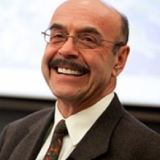I have had the privilege of co-chairing CJP’s Greater Boston Jewish Community Study three times, in 1995, 2005 and now 2015. This has given me both the opportunity to see how the Greater Boston Jewish community and how we think about it has changed over the decades. Let me reflect both on actual changes and changes in our thinking. In doing so, I do not want to attribute any particular observations to specific individuals or groups. Rather, my aim is an impressionistic account based on my involvement over the last three decades. Most certainly others would see things differently.
1995
In 1995 CJP did not have a Community Study, but a demographic study. This later label reflected the perspectives and concerns of the time. The general belief and great concern was that the Jewish population in Boston was shrinking and the only question was how fast. The 1995 study suggested that this was in all likelihood not true.
A major issue was the rising rates of intermarriage and the consequences of this for Greater Boston’s community. The fear was that intermarried couples would not bring up their children as Jews. As such, Greater Boston’s Jews would eventually shrink to almost nothing. Boston was certainly not unusual in this concern.
At that time, in counting who was Jewish, either you were simply a Jew or not. If you had a Christmas tree, you weren’t counted as Jewish, no matter what you, yourself, claimed. If several religions were practiced in the home, you were simply an apostate. As such, we thought about Greater Boston’s Jewish community as this well-bounded entity that could simply be enumerated by counting who was inside the boundary.
It was also assumed that one’s Jewishness could be defined by one’s religious practice and involvement in Greater Boston’s various Jewish institutions. Individuals were thought to fall somewhere in a series of concentric circles with those at the center being those with the most extensive religious practices and involvements. How Jewish one was remained defined by how far one was from the center; that is, what circle one was in.
An additional concern was that the Jewish population was becoming more suburban, with families in particular moving west and south due to Boston’s high housing prices. As such, there was growing need for Jewish institutions, such as synagogues and Jewish community centers, to be located in new places. The concern was that existing institutions to a great extent were not located where the Jewish population was growing.
2005
The big surprise with the 2005 study was that a majority of intermarried couples, perhaps as many as 60 percent, were bringing their children up as Jews. This result made the news in the national Jewish media and was contested by many. In the end, the result held firm. CJP’s efforts and those of the Greater Boston Jewish community more generally to be inclusive were paying off.
The effort at inclusivity meant that Greater Boston’s Jewish community was no longer thought of as being defined by some sharp boundary. Rather, it was understood that people were involved to different degrees and in different ways. Importantly, the community of concern for CJP came to be defined as all households in Greater Boston that contained at least one individual who identified as being Jewish.
The 2005 study also showed that the Jewish population was growing, albeit slowly. Under the new, broader definition that counted households with at least one Jewish person, it was quite large, with over 270,000 individuals living in a Jewish household. Furthermore, a large minority of these households, about a third, consisted of intermarried couples.
2015
The 2015 study has brought new insights and surprises. Now nearly half of all Jewish households (47 percent) consist of an intermarried couple. Mirroring national trends of moves back to cities, whereas nearly 50 percent of Jewish households were suburban in 2005, only 37 percent were in 2015. Furthermore, there has been considerable growth in the Jewish population in the Cambridge/Somerville/Arlington area. This raises again the question of whether Boston’s Jewish institutions are in the right locations. Also mirroring national trends, fewer households contain children. Because individuals are marrying later and living longer, we are seeing both among Jews and non-Jews alike a far greater portion of an individual’s life being spent in a childfree household. Jewish institutions need a far broader scope than just families with children.
Unique with the 2015 report is analysis that directly attempts to classify individuals into different “types.” The researchers at the Cohen Center for Modern Jewish Studies used a sophisticated statistical technique known as “latent class analysis” to assign individuals to different groups based on their religious practice, institutional involvements, Jewish interests and relation to Israel. The key finding here is that the concentric-circle model reflecting different intensities of involvement does not work. There are five groups in all. Arguably four groups—the “immersed,” “affiliated,” “familial” and “minimally involved”—are consistent with a concentric-circle model. However, there is a fifth group, the “cultural” group, that consists of individuals “with high rates of participation in Jewish cultural activities. Nearly all regularly visit Jewish or Israel websites and follow news about Israel.” Synagogue membership and broad religious practice, however, is uncommon.
Jewish identity appears, at least now, to be more complex than has been assumed in the past. One of the most striking findings in the comparison of 2015 to 2005 is the massive drop in denominational affiliation. In 2005, 79 percent of individuals affiliated with a denomination (Orthodox, Conservative, Reform or Reconstructionist/Renewal), whereas only 52 percent did in 2015. There is no strong evidence, however, that people are being less Jewish. Rather, it appears that they are finding different and diverse ways to live a Jewish life.
As I hope my impressionist account of changes from 1995 to 2015 and thinking about Greater Boston’s Jewish community conveys, our community is constantly an evolving one. As such, we have new policy and programming challenges. It will be most interesting to see what we learn and what has changed when the 2025 study is done.
Read the 2015 Greater Boston Jewish Community Study here.
This post has been contributed by a third party. The opinions, facts and any media content are presented solely by the author, and JewishBoston assumes no responsibility for them. Want to add your voice to the conversation? Publish your own post here. MORE



